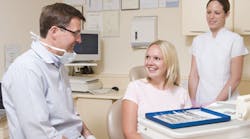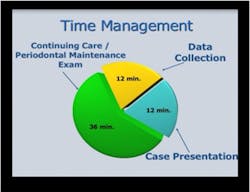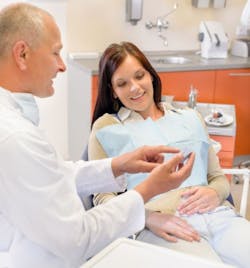By Debbie Seidel-Bittke, RDH, BS
Do you feel stressed knowing that there is going to be a patient exam in the hygiene room? Are you concerned that the exam is only going to keep you waiting and running behind? Do you wish that this process could be quicker yet more effective? As a practice management consultant, this is one of the most common complaints I receive from hygienists and doctors.
The hygienists tell me that the doctor keeps them waiting. Some hygienists say that a doctor will chitchat for what seems like 20 minutes. The doctor wants “to talk about my patient’s personal life, and I don’t have time for this!”
Related article | Shaping the new dental patient experience
In contrast, doctors state that, when they get to the hygiene room, there has been no conversation about the patient’s teeth. When they arrive to do the hygiene exam, there is no conversation — period! The hygienist says nothing when doctor enters to complete the patient exam. Some doctors, who have never even met the patient, don’t even get a proper introduction to the patient.
By the way: The doctor should at least say a brief “hello” to all new patients before any services begin. Also, the doctors will be known as the experts and will be respected if they can let the new patient know they are making an individual diagnosis for a specific type of X-ray(s) before hygiene treatment begins. This makes new patients really feel like they are king or queen, like they are VIP. This is only one way to gain raving fans!
Step 1: Create a strategic plan for the exam.
Break up every routine prophylaxis and periodontal maintenance appointment into three areas. These three areas (shown in the table above) are: 1. data collection, 2. case presentation, and 3. the hygiene treatment and doctor exam.
Step 2: Discovery and explanation.
During the data collection, decide what you must know in order to treat your patient at the highest level of care. Much of your information needs to be determined prior to the patient’s arrival.
Every hygienist should take time at the beginning of their day — before the morning team huddle — to review the patients’ charts, routing slips, X-rays, previous chart notes, and to discover what the current oral health and systemic health status may (and should) be at the time of the appointment.
Related article | Hygiene department efficiency
The hygienist will review each patient’s chart to see if the patient needs to complete a new health history. It is always best if you anticipate the need for a new health history prior to the patient’s arrival. The hygienist needs to be aware of medications, herbs, vitamins, and OTC medications that the patient is currently taking. Ask if the patient is taking any new medications when they are first seated in your chair. Ask if they have had any recent hospitalizations, surgeries, etc. All providers need to ask these medical history questions prior to beginning any treatment. Always review the chart before the patient has arrived for their appointment and understand if they have diagnosed treatment that is unscheduled.
Are there other family members who are overdue for a hygiene appointment? Look at the routing slip and report on this at the morning team huddle.
Once patients arrived, you will inquire about whether they have a chief complaint. Annually take blood pressure and chart it. Refer patients to their physicians if they appear to have blood pressure that is not within normal limits. You will be saving a few lives when you discover patients who need to be on blood pressure medication but have not seen their physician.
Ask all patients if they ever experience dry mouth, which indicates that they are at high risk for caries or at least need a rinse for dry mouth, etc. Ask about frequent headaches, clicking of the jaw, or pain in the jaw, which is a possible sign that they may need a night guard.
Annually complete an oral screening with the latest technology (ViziLite, VELscope, Identafi, etc.) to screen for any precancerous lesions. Oral cancer is on the rise due to HPV in young adults (Have you read the research about this?).
Annually, provide a full-mouth periodontal screening exam. This will include a six-point probing along with documentation of recession, bleeding points, mucogingival involvement, furcations, mobility, suppuration, etc. It helps to get the patient involved if you can explain what these numbers mean before you call them out. Explain it before you pick up a probe and lay the patient back to begin any screenings.
Involve the patient by asking them to listen for the highest and lowest numbers that you will call out. Once you have completed your screenings, sit the patient up in the chair and ask what the highest and lowest numbers are that they heard you call out. This will help with the co-diagnosis process and getting patients' buy-in on case acceptance.
If you do not have another team member available to write down the periodontal probings while the hygienist calls out the numbers, use a voice recorder. Later, listen to your probe readings, and you can quickly write the findings in the patient's chart.
Before the patient arrives, you should know if they need bitewings or a full mouth series of X-rays. In fact, the chart audit by the hygienist that day should only be a double check to see if everything is correct on the schedule. Usually, patients will be have been pre-scheduled for the X-rays at the end of their last hygiene appointment.
Step 3: Complete the doctor exam sooner rather than later.
There is no need for the doctor to wait until the end of the hygiene appointment to complete the hygiene patient exam. At approximately 35 to 45 minutes into the 60-minute hygiene exam, the doctor’s assistant should be able to give the doctor a nudge to move into the hygiene treatment room to complete the hygiene patient exam.
There is no need for the hygienist to get up or stop what he or she is doing to notify the doctor about a hygiene exam. This should be standard procedure for every routine hygiene care appointment. If there is a change, the hygienist can notify doctor or the assistant of the exam.
As a dental practice management consultant, I have worked with hundreds of offices that use this system, and it has de-stressed many hygienists and doctors. It has created thousands of happy patients who felt that they were given optimal care without having to sit and wait for the doctor.
Using this strategic plan for doctor/hygiene exams will create a stress-free day for the entire team and will have your patients leave your office feeling like you are the world’s best dental provider.
Would you like more ways to increase profits in your dental hygiene department? Get your complimentary subscription to our weekly Dental Profits Newsletter. You will also receive our 7-Day Dental Hygiene Profit Tips when you subscribe here.









